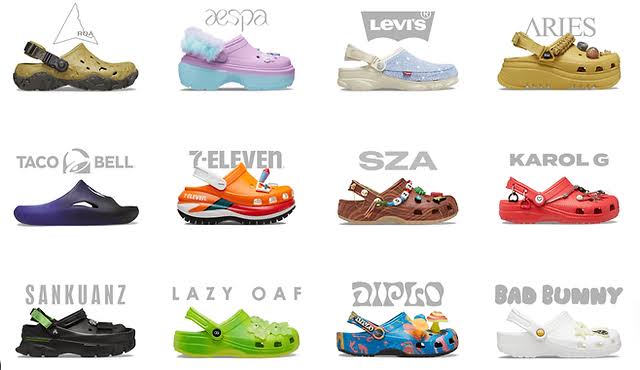👟 Welcome to Crocsy Vibe – Where Comfort Meets Global Style! 🌈
Crocs 2025: Fashion Trends & Sustainability Insights
Discover how Crocs is balancing big wins and challenges in 2025. Explore bold styles, sustainability programs, and innovative marketing strategies that keep Crocs a trendsetter in comfort-driven fashion amidst competition and supply chain pressures.
SHARAD RAJGURU
7/25/20258 min read


Introduction: The Evolution of Crocs
Since its inception in 2002, Crocs has undergone a remarkable transformation within the footwear industry. Originally launched as a functional, waterproof clog aimed at boaters and outdoor enthusiasts, the brand quickly gained popularity due to its comfort, lightweight design, and unique aesthetic. Over the years, Crocs has managed to expand its appeal beyond its initial target market, evolving into a versatile footwear option embraced by a diverse demographic, including fashion-forward individuals and casual wear enthusiasts.
Throughout its journey, Crocs has successfully navigated various market trends and consumer preferences. The company's ability to adapt its product offerings has been a key factor in maintaining relevance in the competitive footwear landscape. The transition from the classic clog design to a broader range of styles, including sandals, slides, and collaborations with high-profile fashion brands, has positioned Crocs as a fashion staple rather than merely a functional item. This shift underscores the brand’s commitment to innovation while addressing the needs and desires of its customers.
As of 2025, the brand stands at a significant crossroads, having witnessed both market highs and lows over the past two decades. Factors such as social media influence, celebrity endorsements, and a growing trend toward comfort-oriented fashion have significantly impacted Crocs' market presence. The company has also faced challenges, including competition from other brands and shifting consumer behaviors influenced by the global economic climate.
Understanding the evolution of Crocs provides a context for analyzing its current status within the market. As we delve deeper into the specifics of Crocs’ market performance in 2025, the previous developments in design, branding, and consumer engagement will inform our exploration of future prospects and strategic directions ahead for the brand.
Market Highs: Sustained Sales Growth
In 2025, Crocs has demonstrated remarkable sustained sales growth, primarily driven by a combination of strategic collaborations, innovative marketing, and product diversification. A pivotal aspect of this success has been the brand's high-profile partnerships with celebrities and prominent designers. Collaborations, such as those with famous figures from the fashion and music industries, have spurred interest and created compelling narratives around the product. These partnerships have allowed Crocs to transcend its original comfort-focused image, appealing to a wider audience, which has played a significant role in elevating the brand's status.
Effective regional marketing campaigns further bolster Crocs' growth trajectory. By tailoring advertising efforts to resonate with local cultures and preferences, Crocs has successfully tapped into various markets across the globe. Digital marketing strategies, including social media engagement and influencer marketing, have proven particularly effective in attracting younger demographics. The brand has embraced platforms such as TikTok and Instagram, amplifying reach and fostering community engagement through user-generated content, which has positively impacted consumer perception and loyalty.
Moreover, buzz-generating product launches have become synonymous with the Crocs brand. Innovative designs, limited-edition releases, and themed collections have generated excitement and urgency among consumers, translating into increased sales. For instance, the introduction of new materials, colors, and customizable options has captivated both returning customers and new buyers, further diversifying the customer base. As Crocs continues to innovate and adapt its offerings, it remains well-positioned to build on its global momentum, ensuring that the brand not only satisfies current demands but also anticipates future trends. This strategic alignment of celebrity partnerships, regional campaigns, and innovative product development is at the heart of Crocs' sustained sales growth in 2025.
Digital Edge: Influencer Marketing and Social Media
In recent years, Crocs has adeptly harnessed the power of digital marketing strategies, particularly emphasizing influencer collaborations and the virality of content on social media platforms. This approach has not only bolstered the brand's visibility but has also redefined its consumer engagement strategy. Social media channels such as Instagram, TikTok, and Twitter have served as critical avenues for Crocs to showcase its unique offerings, influencing consumer perceptions and driving sales.
One notable example of Crocs' successful influencer marketing is their partnership with celebrities and fashion influencers, who have actively endorsed the brand. These collaborations often feature influencers styling Crocs in innovative ways that highlight their versatility, allowing them to transcend their traditional perception as casual footwear. This not only appeals to a fashion-conscious audience but also opens Crocs to new demographics, effectively broadening its customer base. The significance of these partnerships is evident when analyzing the engagement metrics, as posts involving influencers frequently garner higher interaction rates, including likes, shares, and comments.
In addition to traditional influencer collaborations, Crocs has also tapped into the power of user-generated content and viral trends. Campaigns such as the "Crocsyourself" challenge on TikTok invited users to showcase their creativity by styling their Crocs in fun and imaginative ways. This grassroots movement not only elevated user engagement but also created a sense of community among consumers, further solidifying brand loyalty. As social media continues to evolve, Crocs' innovative digital strategies exemplify how the brand has maintained its relevance in a competitive market, directly linking social media engagement to increased sales and positive brand perception.
Market Lows: Challenges and Roadblocks
In 2025, Crocs faces a myriad of challenges that could impact its position in the competitive footwear landscape. The footwear market is saturated with numerous brands vying for consumer attention, and the rise of direct-to-consumer models has further intensified competition. Proliferation of alternatives, especially within the casual footwear segment, has made it increasingly difficult for Crocs to maintain market share. Brands that were once seen as rivals have evolved, introducing innovative designs and sustainability initiatives that appeal to environmentally conscious consumers.
Furthermore, supply chain disruptions remain a significant issue. Global logistics have been strained, resulting in delays and increased costs for companies like Crocs. The lingering effects of the COVID-19 pandemic, along with geopolitical tensions, have exacerbated these disruptions. Such challenges not only hinder the timely availability of Crocs products but also inflate production costs, necessitating strategic reconsiderations regarding pricing and inventory management. This includes navigating potential raw material shortages, which could further complicate manufacturing processes.
Shifting fashion trends present another hurdle for Crocs as consumer preferences evolve rapidly. The trend towards minimalism and sustainability challenges traditional notions of comfort and style. Although Crocs has made strides in integrating fashionable elements into its classic designs, it must continue to innovate to resonate with younger, trend-sensitive shoppers. The brand's public perception also plays a pivotal role, as it often grapples with mixed reviews about its aesthetic appeal. Overcoming negative stereotypes is crucial for the company’s growth and market positioning.
Addressing these roadblocks will require a multifaceted strategy that includes diversification of product offerings, strengthening supply chains, robust marketing efforts, and engendering positive public sentiment. Understanding these market lows will help Crocs identify potential pathways to not only sustain its presence but also to thrive in the ever-evolving landscape of the footwear industry.
The Role of Sustainability in Crocs' Strategy
Crocs has increasingly recognized the essential role of sustainability in shaping its business strategy, responding to a growing demand for eco-friendly practices within the fashion industry. As contemporary consumers become more environmentally conscious, brands like Crocs are adopting innovative approaches that prioritize sustainability, resonating with modern values and influencing purchasing decisions.
In recent years, Crocs has initiated several programs aimed at minimizing its environmental impact. One significant step has been the commitment to using recyclable materials in the production of its footwear. By introducing proprietary Croslite™ material, which is not only lightweight and durable but also easier to recycle, Crocs aims to reduce the quantity of waste generated during and after the product lifecycle. Furthermore, ongoing efforts to enhance the recyclability of their products align with the company's vision of creating a circular economy model within the footwear sector.
Moreover, Crocs' Sustainability Report outlines various initiatives aimed at reducing their carbon footprint, including energy-efficient manufacturing processes and optimizing supply chain logistics. By transitioning to renewable energy sources for its factories, Crocs significantly minimizes greenhouse gas emissions. This commitment to sustainability extends to packaging as well; the company has pledged to reduce its packaging materials and utilize eco-friendly alternatives to minimize plastic waste.
These sustainability initiatives are not merely operational but serve to connect with consumers who prioritize environmental responsibility. Modern buyers are increasingly influenced by a brand's commitment to sustainable practices, which can greatly enhance customer loyalty. As Crocs continues to innovate and enhance its eco-friendly offerings, it seeks to position itself favorably in a competitive market that increasingly values both style and sustainability. The alignment of Crocs' business model with the principles of sustainability ensures relevance and adaptability in an ever-evolving consumer landscape.
Consumer Trends Shaping the Future of Crocs
As we look towards the future of Crocs in 2025, it is essential to understand the consumer trends that are likely to shape the brand's trajectory. One of the most significant trends influencing the footwear industry is the shifting fashion preferences among consumers. In recent years, there has been a marked inclination towards versatile and comfortable footwear, which complements the evolving lifestyle choices of people today. Crocs has had the advantage of being at the intersection of comfort and style, making it well-positioned to capitalize on this shift.
The rise of athleisure is another critical trend that is expected to have a profound impact on the market. The athleisure movement has revolutionized how consumers approach daily wear, favoring outfits that seamlessly blend sportiness with casual aesthetics. This trend has proven that practicality and style can coexist, a philosophy that aligns closely with Crocs' product offerings. As consumers increasingly seek footwear that can accompany them through various activities—ranging from exercise to casual outings—Crocs can enhance its appeal by introducing innovative designs that feature performance elements synonymous with athleisure apparel.
Moreover, the demand for comfort in footwear cannot be underestimated. In a world where consumer well-being takes precedence, comfort is paramount. Research consistently reveals that consumers prioritize comfort, particularly when selecting footwear for everyday wear. Crocs, known for its ergonomic designs and cushioned soles, stands to gain significantly as customers gravitate towards shoes that prioritize foot health without compromising style. By continuously innovating and responding to these consumer preferences, Crocs can adapt its marketing strategies and product designs to meet the evolving needs of its target audience.
The Road Ahead: Future Strategies and Innovations
As Crocs continues to navigate the dynamic landscape of the footwear industry, several strategies and innovations appear poised to enhance its market presence. With an increasing emphasis on sustainability, Crocs may venture into eco-friendly materials and production methods, appealing to environmentally conscious consumers. The use of plant-based materials or recycled plastics could serve as a cornerstone for new product lines, allowing Crocs to reinforce its commitment to environmental stewardship while appealing to a wider demographic.
Collaboration remains a critical aspect of Crocs' strategy moving forward. Building upon successful partnerships with renowned fashion designers and celebrities, Crocs can further expand its brand appeal. Exclusive limited-edition releases and unique co-branded collections could spark consumer interest and create buzz, enhancing brand loyalty. A strategic alliance with other major brands could also open doors to novel styles, merging Crocs’ comfort with the innovative designs of its collaborators.
Technological advancements in shoe manufacturing may also play a significant role in Crocs' future. The incorporation of smart technologies, such as integrated sensors for tracking comfort levels, could provide a competitive edge in the market. Innovations in 3D printing and customization options may allow customers to personalize their footwear, fostering a deeper connection between the brand and its consumers. Adapting to the online marketplace will remain essential as well, with an emphasis on enhancing digital customer experiences through augmented reality fitting tools and personalized shopping options.
Ultimately, the road ahead for Crocs seems to be paved with opportunities for innovation and growth. By anticipating consumer trends, embracing sustainable practices, and leveraging technological advancements, Crocs can ensure it remains a relevant leader in the ever-evolving footwear market. This adaptability will be crucial as the brand strives to meet the diverse needs of its consumer base while navigating potential challenges in the upcoming years.

Get in touch
Address
3721 Single Street
Quincy, MA 02169
Contacts
123-456-7890
info@email.com
